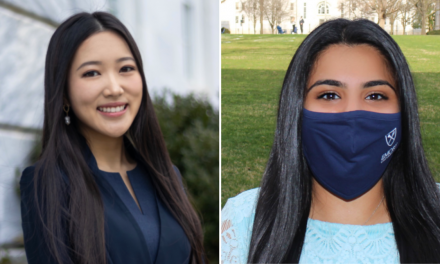Several Emory Law students have sent a case to the highest court in the land: the United States Supreme Court.
Next spring the Emory Law School Supreme Court Advocacy Project (ELSSCAP) will represent Randy Bullock in a case concerning whether federal bankruptcy law allows one to discharge his or her debt.
ELSSCAP filed a petition for writ of certiorari in the case Bullock v. BankChampaign N.A. on June 14, 2012, and on Oct. 29, 2012 the Supreme Court granted the petition. A petition for writ of certiorari, or cert. petition, is a request for a judicial review from a higher court after a lower court has already ruled on the case.
The Supreme Court receives around 8,000 cert. petitions per term, which starts and ends on the first Monday in October. The Court grants about 80 of them, making the acceptance rate approximately 1 percent.
About ELSSCAP
ELSSCAP is a student-run organization that reviews cases released by the 13 courts of appeals and the Supreme Courts of the 50 states. ELSSCAP decides which of them are inconsistent with a federal law, according to founder of ELSSCAP and third-year law student, Kedar Bhatia.
The organization is distinct among its kind because the project is completely student run, Bhatia explained. Organizations at other law schools are clinics, meaning they are classes that give students credit.
ELSSCAP partners with three law firms. When they decide to pursue a case for certiorari, they ask one of the law firms to act as lead counsel for the case pro bono.
“When you go up to the Supreme Court, there are a series of briefs that are written beforehand which really are the meat of the argument … The students do all the research and the writing, which gets edited by the outside counsel we have,” said Louis Laverone, a third-year law student and ELSSCAP’s current president.
According to Sarah Shalf, faculty advisor for ELSSCAP and director of Emory’s Field Placement and professionalism programs, it writes both cert. petitions and amicus briefs. An amicus brief – or friend of the court brief – is when a third party provides information to help the court make a decision.
“The project does outstanding work … [It] is a great example of Emory Law’s commitment to integrate theory and practice to provide the best education for our students and the best service to society,” said Robert Schapiro, the School of Law’s Dean and Asa Griggs Candler Professor of Law.
The Process
The justices’ law clerks read all the cert. petitions and produce summaries for the justices. For a cert. petition to be accepted, four of the Court’s nine justices must vote to grant it during their meeting called a Conference; this is referred to as “the rule of four.”
Justices accept cert. petitions if they are compelling – that is, if justices are interested by the legal issue in question or believe a law needs to be standardized in its application.
A decision to grant or deny cert. does not express an opinion on the outcome of the decision. Rather, the Supreme Court deems a “cert. worthy” case as one that warrants judicial review by the highest court in the land because of an inconsistent interpretation of the law.
When ELSSCAP reviews cases for cert., there are a few specific qualities it looks for. It first looks to see if there is “a division in the law,” according to Laverone.
That is, an issue that has been addressed by many of the lower courts has come up with different standards.
The role of the Supreme Court is to resolve this split and provide a standardized interpretation of federal law.
“Most people think of the Supreme Court as deciding all these sexy cases involving constitutional rights and big policy issues, but actually a lot of the Supreme Court’s role is interpreting federal law,” Shalf said.
ELSSCAP also pursues cases in which the client has limited resources.
Finally, ELSSCAP looks for what Laverone describes as “a good justice story.” Usually this appears in the form of a client who believes he or she has been unfairly convicted or has received a disproportionate punishment. The Supreme Court is in a position to reverse this wrong.
For the Supreme Court to have granted a cert. petition written by Emory law students is a tremendous achievement on ELSSCAP’s part, according to Schapiro.
The Case
In the case in question, Bullock v. BankChampaign N.A., the U.S. Court of Appeals for the 11th District ruled against Randy Curtis Bullock, who sought to discharge his debt through bankruptcy.
Bullock, who is from Illinois, became the trustee for a fund created by his father in 1978. Bullock’s siblings, who were beneficiaries of the trust, sued him over three loans he made from the trust. The loans totaled about $264,000 and were for repaying a debt and purchasing various real estate.
When Bullock’s siblings asked him to resign as trustee in 1998, he and his mother paid back the loans in full with interest, totaling about $455,000.
His siblings’ lawsuit accused him of breaching his fiduciary responsibility by self-dealing – he was accused of mismanaging the money by acting in her own interests.
The judge ordered Bullock to pay $250,000, the amount he purportedly benefitted from the loans in addition to $35,000 in attorney fees.
“He didn’t intend to do anything wrong, but in a technical sense it was improper; he wasn’t a professional trustee,” said Shalf.
In 2009, unable to payoff the $250,000, Bullock filed for bankruptcy protection in Alabama. However, BankChampaign, which was the bank that took over the trust after Bullock, asked the court not to discharge Bullock’s debts, arguing that his conduct constituted “defalcation.”
An archaic term first used in the 15th century, “defalcation” has never had a clear definition in practical application, according to Shalf.
Most dictionaries define it as a misappropriation of money or as synonymous with embezzlement.
In Bullock’s case, there was a rather clear division in the lower courts on what the word meant, according to Shalf. Under the Bankruptcy Code, debt that is due to “defalcation” of someone who has fiduciary responsibility cannot be relieved.
The original ruling acknowledged that there was no malicious intent on Bullock’s part, and in addition there was no money loss for the fund. The dispute, though, is over whether Bullock’s alleged misconduct constitutes “defalcation” under 523(a)(4) of the Bankruptcy Code.
ELSSCAP and Sutherland, Asbill & Brennan, a partner firm, worked together and advocated in the cert. petition that Bullock’s lack of malicious intent exempts him from the “defalcation” clause of the Bankruptcy Code.
The petition asks the Supreme Court to reconsider the lower court’s ruling on Bullock’s degree of misconduct.
The Supreme Court will determine whether his good intentions exonerate him, and thus whether his debt is eligible for a bankruptcy discharge.
The Outcome
The Supreme Court, according to Shalf, could have granted cert. for a number of reasons.
“It may be that there are some justices on the court that are particularly intrigued by archaic words like ‘defalcation,'” she said.
Shalf cited Justice Antonin Scalia, who is often intrigued by the interpretation of these words and their etymological histories.
The Court might also recognize that bankruptcy is becoming a bigger issue in America, according to Shalf.
Neither Shalf nor Laverone have predictions as to how the Court will vote on Bullock v. BankChampaign N.A.
The case is difficult to predict because there won’t be any preconceived liberal or conservative partisan divisions, Shalf said.
As for the case’s effect on ELSSCAP and Emory Law School, Schapiro says, “The publicity will likely attract more cases to the Project … I think Bullock v. BankChampaign will increase interest in Emory Law School among perspective students.”
The case is scheduled for oral arguments in front of the Supreme Court in February 2013.
By Rupsha Basu
The Emory Wheel was founded in 1919 and is currently the only independent, student-run newspaper of Emory University. The Wheel publishes weekly on Wednesdays during the academic year, except during University holidays and scheduled publication intermissions.
The Wheel is financially and editorially independent from the University. All of its content is generated by the Wheel’s more than 100 student staff members and contributing writers, and its printing costs are covered by profits from self-generated advertising sales.




